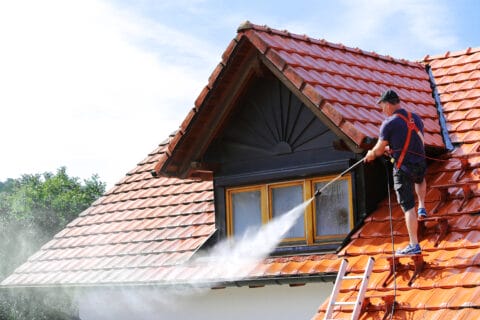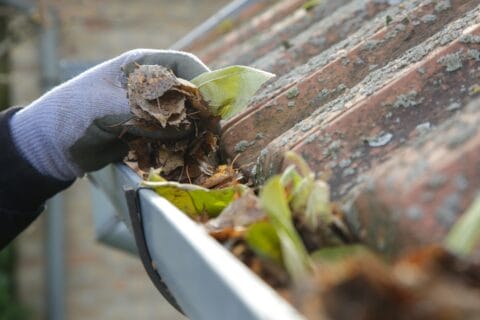How to Fix a Leaking Gutter?
 Revised by Bruce Hulse
Revised by Bruce Hulse
Leaky gutters may seem minor initially, but if left unaddressed, they can lead to severe damage affecting your home’s foundation, landscaping, and exterior walls. Quickly identifying and repairing gutter leaks protects your home’s structural integrity, prevents costly repairs, and maintains its curb appeal and overall value. This comprehensive guide walks you step-by-step through identifying leaks, understanding common causes, and performing effective repairs.
Why Gutter Maintenance Matters
Properly functioning gutters channel rainwater away from your home’s foundation, preventing water infiltration and structural damage. When leaks occur, they disrupt this process, causing water to pool near your foundation. This pooling can lead to foundation erosion, basement flooding, and deterioration of exterior walls. Regular gutter maintenance and prompt leak repairs thus become essential aspects of responsible homeownership.
Common Causes of Gutter Leaks
Identifying the root cause of leaks makes repairs more effective and prevents recurrence. Most gutter leaks originate from:
Faulty joints and seams—these are frequent leak points as gutters shift or sag over time.
Small holes and cracks—often caused by rust, debris impact, or prolonged weather exposure.
Clogs from debris—leaves, twigs, and sediment can obstruct water flow, leading to overflow and gutter damage.
Improper installation—incorrect slope or alignment issues can lead to persistent leaking.
Regularly inspecting these areas can help homeowners detect early signs of gutter deterioration before leaks escalate into more extensive issues.
Signs Your Gutter is Leaking
Early detection significantly simplifies repairs. Key signs indicating potential leaks include water stains or streaks along exterior walls, mold growth near gutter edges, pooling water around your home’s foundation, visible sagging gutters, and overflow during rainstorms. Audible dripping sounds after rainstorms can also confirm the presence of leaks. Recognizing these indicators allows homeowners to take immediate corrective action before damage spreads.
Where Gutter Leaks Typically Occur
Leaks most commonly develop at gutter joints, seams, and connections to downspouts, where two pieces meet and are sealed together. These areas experience constant water flow and pressure, making them particularly susceptible to weakening seals and cracks. Regular inspections, particularly after seasonal changes, can help homeowners promptly identify and address these vulnerable spots.
How Weather Impacts Gutter Integrity
Weather is a primary factor influencing gutter longevity and functionality. Harsh Canadian winters, heavy rainfall, ice buildup, and freezing temperatures can cause gutters to crack, split, or detach from the fascia board. Ice dams are especially problematic, placing substantial weight on gutters and accelerating wear and tear. Seasonal preventive maintenance, especially in fall and spring, helps mitigate weather-related damage, ensuring gutters remain functional and leak-free.
Essential Tools and Materials for Repair
Before beginning any gutter repair, gather the necessary materials and safety equipment. Homeowners typically need plastic roofing cement for small leaks, silicone caulk for joint sealing, flashing and tin snips for larger patches, and durable gutter sealants. Safety equipment such as gloves, protective eyewear, and a stable ladder is essential to ensure your safety while working at heights.
Step-by-Step Guide to Fixing Leaky Gutters
A structured repair process ensures thorough and lasting fixes. Here’s how homeowners can systematically approach common gutter repairs:
Step 1: Clean and Inspect Gutters Thoroughly
Start by removing all debris and leaves, ensuring gutters are thoroughly cleaned out. Rinse gutters using a garden hose and closely observe water flow. Leaks become readily apparent during this flushing process, making it easier to pinpoint exact locations needing repair.
Step 2: Seal Small Holes and Cracks
Smaller holes (less than half an inch) can be effectively sealed using plastic roofing cement. Apply a generous layer directly over the hole, spreading it at least two inches beyond the edges for complete coverage. Allow ample drying time before testing for leaks again with your hose.
Step 3: Patch Larger Holes with Flashing
Larger holes require sturdy metal patches. Cut a piece of metal flashing slightly larger than the hole using tin snips. Coat the area around the hole with roofing cement, firmly press the metal patch into the cement, and then apply an additional layer of cement over the flashing edges to ensure a watertight seal.
Step 4: Properly Seal Joints and Seams
Gutter joints and seams are common leak spots. Apply a bead of waterproof silicone caulk along the seams and joints. Smooth the caulk using your finger or a small tool, ensuring thorough coverage to maintain a tight, secure seal. Let the caulk cure fully before testing.
Step 5: Check and Adjust the Gutter Slope
Proper gutter slope prevents standing water. Ideally, gutters should slope about ¼ inch downward for every 10 feet toward the downspout. Use a level to check this slope and adjust hangers if necessary to correct any flat or negative slope areas, eliminating water pooling.
Downspout Maintenance and Replacement
Effective gutter maintenance includes routine care of downspouts. Damaged or clogged downspouts can quickly reverse the effectiveness of even properly maintained gutters.
Inspecting Downspouts for Damage
Regularly check your downspouts for cracks, blockages, rust, and loose connections. Identifying and fixing these problems promptly helps ensure your gutter system effectively diverts water away from your home’s foundation, protecting against basement leaks and foundation erosion.
How to Replace a Damaged Downspout
Replacing a downspout is a straightforward but essential maintenance task:
-
Remove the damaged downspout carefully by detaching brackets and loosening any connecting joints.
-
Measure, cut, and install the new downspout, aligning it properly with existing gutters.
-
Secure the new downspout firmly with brackets and apply silicone caulk at all connections for watertight seals.
Proper downspout installation ensures efficient water drainage, protecting your property from unnecessary water exposure.
Preventive Maintenance to Avoid Future Leaks
Prevention is the most effective approach to gutter maintenance. Regular proactive care reduces the likelihood of leaks and extends gutter longevity significantly.
Seasonal Gutter Cleaning and Care
Gutters should ideally be cleaned at least twice annually—in spring and autumn. Post-fall cleaning is especially crucial due to heavy leaf debris accumulation. Removing leaves and other debris prevents clogs, water overflow, and associated leaks, keeping gutters fully functional year-round.
Routine Inspection Checklist for Homeowners
Periodically inspect gutters for early warning signs such as cracks, rust spots, loose brackets, sagging sections, and peeling paint. Early intervention minimizes the extent of repairs and maintains gutter effectiveness. Consider setting quarterly reminders to perform these inspections.
Understanding Your Gutter’s Lifespan
Knowing the typical lifespan of your gutter system helps homeowners anticipate potential issues. Aluminum gutters typically last around 20 years, while copper systems can exceed 50 years. If your gutters approach or exceed these benchmarks, consider scheduling more frequent inspections or proactive replacements.
Add-On Solutions for Longer Gutter Life
Protect Gutters with Gutter Guards
One effective solution homeowners can consider to enhance gutter performance is the installation of gutter guards. These devices are particularly useful in Ottawa, where seasonal leaf fall and tree debris can quickly clog gutters. By significantly reducing the entry of leaves, twigs, and other debris, gutter guards help prevent blockages that could lead to leaks or overflowing water. Although an upfront investment is required, the long-term savings in time, effort, and maintenance costs make gutter guards a highly worthwhile addition for most homes.
Extend Lifespan with High-Quality Sealants
Selecting the right gutter sealant also plays a crucial role in maintaining gutter integrity. High-quality, weather-resistant sealants—specifically designed for gutter materials such as aluminum or vinyl—provide durable protection at vulnerable points like joints, seams, and corners. Applying sealants proactively at these critical areas helps prevent minor cracks or leaks from developing into major issues. Homeowners should regularly inspect their gutters, reapplying sealants every few years or when signs of deterioration first appear, ensuring ongoing protection.
Regular Professional Inspections
Another valuable measure homeowners can adopt is scheduling periodic professional gutter inspections. While DIY inspections and maintenance are essential, having a professional team periodically review your gutter system ensures that subtle signs of wear or potential leaks are caught early. Professionals can also suggest targeted solutions, adjustments to gutter slopes, and reinforcement of key structural points. Such proactive care prolongs gutter lifespan, optimizes drainage efficiency, and contributes significantly to protecting your home’s structural integrity.
Conclusion: Protecting Your Home Through Vigilant Gutter Maintenance
Gutter maintenance might seem minor, yet it’s an essential homeowner responsibility. Promptly fixing leaks, maintaining correct slope, regularly cleaning debris, and investing in preventive solutions like gutter guards collectively protect your home’s foundation and exterior. Through vigilant care and timely repairs, your gutter system will function effectively, preserving both your home’s safety and its long-term value.
FAQs About Gutter Repair and Maintenance
What’s the easiest way to find a gutter leak?
Inspect gutters during a rainstorm or flush them with a hose. Carefully look for dripping, pooling, or overflow points indicating leaks.
How often should gutters be cleaned?
Clean gutters at least twice a year—once in spring and once in fall. More frequent cleanings may be necessary for heavily wooded areas.
Can gutters be repaired in bad weather?
Repairs are best performed in dry conditions, as sealants adhere better and safety hazards are minimized when conditions are dry.
Are gutter guards worth the investment?
Yes, particularly in areas with dense tree coverage. They significantly reduce debris buildup and maintenance frequency.
Where can I buy gutter repair supplies?
Gutter repair materials are readily available at home improvement stores, hardware retailers, and online marketplaces, often with convenient delivery options.


